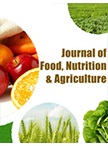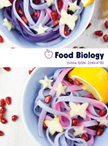Potato and tomato peel extract – A natural antioxidant for retarding lipid peroxidation in lamb meat (Awassi) refrigerator storage
DOI:
https://doi.org/10.21839/jfna.2019.v2i1.179Keywords:
lipid peroxidation, potato and tomato peel extract, meatAbstract
This work examined the utilization of potato and tomato peels, as antioxidants natural source for retarding lipid oxidation in slices of lamb meat (Awassi). Meat slices treated with potato peel extract (PPE) and tomato peel extract (TPE) in two different concentrations (0.1%, 0.5%). Then, lipid peroxidation and pH was determined in samples at three different periods with 5 days. We found low levels of peroxide value in samples due to treatment with natural antioxidants. Potato peel extracts were less effective than tomato peel extracts due to lower phenolic content 96.66 mg of Gallic acid /100 g in potato peel extract vs 130.53 mg of Gallic acid /100 g. We suggest using tomato peel extract for retarding lipid peroxidation in chilled storage of lamb meat.
Downloads
References
Alassaf, A.K. (2003). Studying the effect of garlic, coriander and paprika on some properties of frankfurte. Master Thesis. Food Science and Nutrition Dep. University of Jordan.
Al-Weshahy, A., and Rao, V. A. (2009). Isolation and characterization of functional components from peel samples of six potatoes varieties growing in Ontario. Food Research International, 42, 1062?1066.
Bozin, B., Mimica-Dukic, N., Samojlik, I., and Jovin, E.A. (2007). Antimicrobial and antioxidant properties of rosemary and sage (Rosmarinus officinalis L. and Salvia officinalis L., Lamiaceae) essential oils. Journal of Agricultural and Food Chemistry, 55, 7879-7885.
Brand-williams, C.M., and Beraet, C. (1995). Use of a free radical method to evaluate antioxidant activity. Lebensmittel-Wissenschaft & Technologie, 1, 25-30.
de Sotillo, D.R., Hadley, M., and Holm, E.T. (1994). Phenolics in aqueous potato peel extract: extraction, identification, anddegradation. Journal of Food Science, 59, 649-651.
Elbadrawy, E., and Sello, A. (2016). Evaluation of nutritional value and antioxidant activity of tomato peel extracts. Arabian Journal of Chemistry, 9(2), S1010-S1018.
Estévez, M., and Cava, R. (2006). Effectiveness of rosemary essential oil as an inhibitor of lipid and protein oxidation: Contradictory effects in different types of frankfurters. Meat Science, 72, 348-355.
Farvin, S., Grejsen, D.H., and Jacobsen, C. (2012). Potato peel extract as a natural antioxidant in chilled storage of minced horse mackerel (Trachurus trachurus): Effect on lipid and protein oxidation. Food Chemistry, 131, 843-851.
Haldeman, D.J., Macneil, J.H., and Yared, D.M. (1987). Antioxidant activity of onion and garlic juices in stored cooked ground lamb. Journal of Food Protection, 50, 411-414.
Jay J.M. (1996). Antioxidants. In: Modern food microbiology (4th Ed.). CBS Publishers and Distributors, New Delhi, India. p 265-266.
Kanatt, S.R., Chander, R., and Sharma, A. (2008). Chitosan and mint mixture: A new preservative for meat and meat products. Food Chemistry, 107, 845–852.
Karastogiannidou, C. (1999). Effects of onion quercetin on oxidative stability of cook-chill chicken in vacuum-sealed containers. Food and Chemical Toxicology, 64, 978-981.
Kumar, S., Yadav, D.N., Ahmad. T., and Narsaiah, K. (2015). Recent trends in the use of natural antioxidants for meat and meat products. Comprehensive Reviews in Food Science and Food Safety, 14, 796-812.
Mansour, E.H., and Khalil, A.H. (2000). Evaluation of antioxidant activity of some plant extracts and their application to ground beef patties. Food Chemistry, 69, 135-141.
McCarthy, T.L., Kerry, J.P., Kerry, J.F., Lynch, P.B., and Buckley, D.J. (2001). Evaluation of the antioxidant potential of natural food/plant extracts as compared with synthetic antioxidants and vitamin E in raw and cooked pork patties. Meat Science, 57, 45-52.
Shahidi, F., Kamil, J., Jeon, Y.J., and Kim, S.K. (2002). Antioxidant role of chitosan in a cooked cod (Gadus morhua) model system. Journal of Food Lipids, 9(1): 57-64.
Shahidi, I., Saba, H., Mubeena, A., Muhammad, Z., and Jamshed, A. (2008). Efficiency of pomegranate peel extracts in stabilization of sunflower oil under accelerated conditions. Food Research International, 41, 194–200.
Singleton, V.L., and Rossi, J.A. (1965). Colorimetry of total phenolic with hosphomolybdic- phosphotungtic acid reagents. American Journal of Enology and Viticulture, 16, 144-158.
Stratil, P., Klejdus, B., and Kubán, V. (2006). Determination of total content of phenlic compounds and their antioxidant activity in vegetables—Evaluation of spectrophotometric methods. Journal of Agricultural and Food Chemistry, 54, 607–616.
Van Gadow, A., Joubert, E., and Hannsman, C.T., (1997). Compression of the antioxidant activity of aspalathin with that of other plant phenols of roolobs tea (Aspalanthus linearis), a-tocoferol BHT, and BHA. Journal of Agriculture and Food Chemistry, 45, 632–638.






 .
.